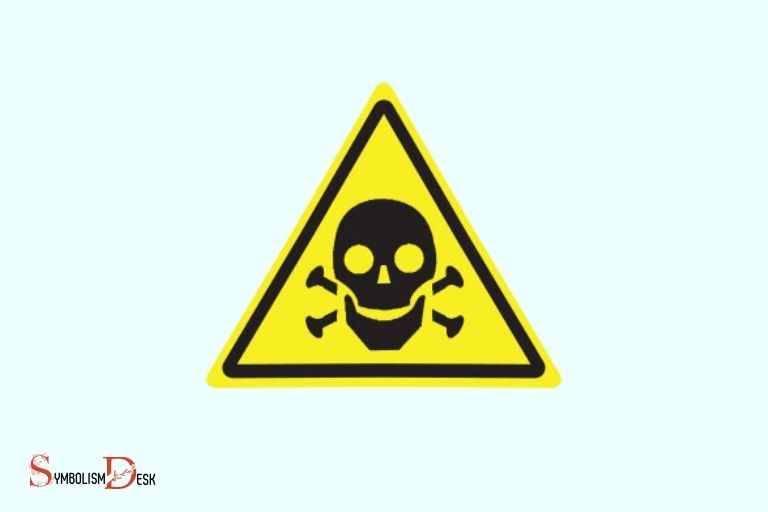Lab Safety Symbols And What They Mean? Maintain Safety!
Lab safety symbols are a set of graphical representations designed to alert individuals about potential hazards in a laboratory setting.
These symbols are universally recognized and used to maintain safety in laboratories worldwide. Some common lab safety symbols include the biohazard symbol, flammable symbol, corrosive symbol, toxic symbol, and radioactive symbol.
Understanding these symbols is crucial in ensuring safety during laboratory operations.
Lab safety symbols play a pivotal role in ensuring the safety of individuals working in a laboratory environment.
These symbols are distinctive and easily recognizable, serving as a warning of the potential dangers one may encounter.
For instance, the biohazard symbol warns of biological substances that carry a risk of infection, while the flammable symbol indicates the presence of a substance that can easily ignite.
Lab safety symbols are an essential aspect of any lab environment. They serve as an immediate warning and reminder of the potential hazards that can be encountered. These symbols are universally recognized and help to ensure the safety and well-being of both students and lab technicians. For example, the flame symbol indicates the presence of a fire hazard, while the radiation symbol warns of potential exposure to radiation. In the same way, the Italian horn symbol meaning is to provide a quick visual alert to the presence of potential dangers or risks in the lab environment.
Understanding and adhering to these safety signs not only protects laboratory personnel but also ensures a smooth and efficient workflow in the lab.
Hence, each lab personnel must be well-versed with these symbols and their implications.
10 Lab Safety Symbols and Their Meanings
| Lab Safety Symbol | Meaning |
|---|---|
| Biohazard | Indicates the presence of biohazardous materials that could lead to severe personal injury or potential death |
| Radiation | Indicates the presence of radioactive materials |
| Flammable Material | Indicates the presence of substances that can easily catch fire |
| Corrosive Material | Indicates the presence of substances that can cause severe burns or damage to materials |
| Toxic Material | Indicates the presence of substances that can cause harm to individuals when inhaled, ingested, or introduced into the bloodstream |
| Explosive Material | Indicates the presence of substances that can cause explosions |
| Oxidising Material | Indicates the presence of substances that can cause or contribute to the combustion of other materials |
| Electrical Hazard | Indicates the presence of potentially dangerous electrical equipment |
| General Warning | Indicates a potential danger or hazard in the lab |
| Health Hazard | Indicates the presence of substances that can cause acute or chronic health effects |
Key Takeaway

Five Facts About: Lab Safety Symbols and Their Meanings
An Introduction To Lab Safety Symbols
Definition Of Lab Safety Symbols
Lab safety symbols are graphical representations used to convey potential hazards in a laboratory setting.
These symbols are universally recognized and serve as a visual aid to warn laboratory personnel of the potential risks associated with carrying out certain experiments or handling specific chemicals.
These symbols are an essential part of laboratory safety practices and are crucial for maintaining a safe working environment.
Here are some of the most common lab safety symbols and their meanings:
- Flame: This symbol is used to indicate that there is a potential fire hazard present in the laboratory. This could be due to flammable materials or gas present.
- Corrosive: This symbol warns of the presence of corrosive substances that have the ability to damage living tissue and other materials.
- Biohazard: This symbol indicates the presence of dangerous biological materials such as infectious agents or genetically modified organisms.
- Radiation: This symbol warns of the presence of radioactive materials or radiation-producing equipment in the laboratory.
- Explosive: This symbol indicates the presence of substances that can cause an explosion if not handled properly.
Importance Of Understanding Lab Safety Symbols
One of the most important aspects of lab safety is understanding the symbols used to identify potential hazards.
It is essential that laboratory personnel be able to recognize and interpret these symbols quickly and accurately to ensure the safety of themselves and others around them.
Here are some reasons why understanding lab safety symbols is important:
- Prevents accidents: Knowing the meaning of lab safety symbols and recognizing when they appear can help laboratory personnel avoid incidents that could lead to serious injury or property damage.
- Promotes safe work practices: Following safety guidelines and using proper protective equipment can help prevent accidents and promote good lab safety practices.
- Saves time and money: Accidents can be costly, and knowing how to avoid them can save both time and money.
Brief History Of Lab Safety Symbols
The use of lab safety symbols dates back to the early 20th century when chemical manufacturers began using labels to identify hazardous materials.
Over time, the symbols evolved and became standardized to ensure universal understanding.
In 1960, the occupational safety and health administration (osha) was established, and they adopted many of the same safety symbols still in use today.
Today, lab safety symbols are color-coded and standardized to ensure that regardless of language or location, laboratory personnel can easily understand and recognize the potential hazards present in their working environment.
Lab safety symbols are essential tools for maintaining a safe working environment in laboratories.
Understanding these symbols can prevent accidents, promote safe work practices, and save time and money.
Different Types Of Lab Safety Symbols
Lab safety symbols are visual representations that warn scientists and researchers about possible hazards in the laboratory. These symbols are used to keep everyone safe and protect them from potential dangers.
Hazard Symbols
Hazard symbols are symbols used to indicate different hazards that may occur in a laboratory. These symbols are usually placed on containers, equipment, and doors to warn researchers and staff of possible dangers.
Here are some common types of hazard symbols:
- Flammable: This symbol depicts a flame, warning of fire hazards.
- Corrosive: This symbol represents two test tubes crossed, indicating the presence of acidic or basic substances that can damage living tissue and equipment.
- Biohazardous: This symbol indicates the presence of hazardous biological material.
- Radioactive: This symbol signifies exposure to dangerous radiation.
Pictograms
Pictograms are graphical representations of hazard information such as health hazards, physical hazards and environmental hazards. Pictograms are very effective at conveying information quickly and efficiently.
Here are some common types of pictograms:
- Skull and crossbones: This pictogram is often used to indicate materials that are toxic or poisonous.
- Gas cylinder: This pictogram indicates that the substance is stored in a pressurized gas cylinder.
- Flame: This pictogram indicates the presence of potentially flammable substances.
- Health hazard: This pictogram represents the danger of not following safe practices, which could lead to injury or illness.
Warning Signs
Warning signs are used to notify laboratory staff of specific dangers and safe practices. They are typically placed near equipment, in laboratory hallways, and entrances and exits.
Here are some common types of warning signs:
- Eye wash station: This sign indicates the location of the emergency eye wash station.
- No smoking: This sign indicates that smoking is not permitted in the laboratory area.
- Chemical storage area: This sign can be used to indicate the storage of hazardous chemicals in the laboratory.
- Electric caution: This sign warns of live electrical wires or equipment.
Safety Colors
Safety colors are colors used to alert individuals of potential hazards. These colors can be used on equipment, in laboratory areas, and even on clothing.
Here are some common safety colors:
- Red: This color indicates danger and is used for emergency-related situations.
- Yellow: This color is used to indicate caution and consider the risks involved before proceeding.
- Green: This color indicates that safety equipment is present, and first aid stations are nearby.
- Blue: This color is used to indicate information, such as where to locate safety equipment.
Knowing and understanding lab safety symbols is essential when working in a laboratory.
By recognizing different types of hazard symbols, pictograms, warning signs, and safety colors, scientists and researchers can keep themselves and others safe. Remember, lab safety is everyone’s responsibility!
Symbols For Chemical Hazards
Lab Safety Symbols And What They Mean
As a scientist, we all work with a number of chemicals in a laboratory. Although these chemicals are essential for our result, they can also be hazardous.
To avoid any accidents and prevent harm, it is important that everyone in the lab understands the lab safety symbols and what they mean.
Flammable Substances
Flammable substances can catch fire easily and can be dangerous if exposed to heat, flame, or sparks.
While working with flammable substances, it is necessary to follow the below guidelines to prevent accidents:
- Use appropriate fire extinguisher(s) in the presence of flammable materials.
- Keep the flammable liquids away from heat sources.
- Don’t use open flames or smoking in the laboratory.
- Store all flammable materials in a designated area (flammable cabinet).
Explosive Materials
Explosive materials can cause serious damage if not used or handled properly. As a result, it is critical to know about their lab safety symbols and handle them with care.
- Wear personal protective equipment (ppe) such as safety glasses or goggles, gloves, and lab coats while working with explosive materials.
- Store these materials in a safe place away from heat and other substances that may cause an explosion.
- Always handle these materials with extreme care to prevent impact, friction, or mechanical shock.
Corrosive Substances
Corrosive substances can cause severe damage to your skin, eyes, and mucous membranes. Furthermore, they can tear through clothing, plastic, and metal.
Here are some essential safety measures to take while working with such substances:
- Wear goggles or protective glasses, gloves, and lab coats while handling these materials.
- Store corrosive materials in specially designed containers to prevent any accidents.
- Do not mix these substances with any other chemicals, heat, or water.
Toxic Chemicals
Toxic chemicals can be highly hazardous to health and can cause serious health issues such as respiratory issues, cancer, and more. Here are some guidelines to follow while handling toxic chemicals:
- Use ppe including gloves, goggles, and face masks while handling toxic substances.
- Store all hazardous chemicals in a ventilated area and keep them properly labeled.
- Understand the material safety data sheet to learn about the toxicity of the chemicals you are working with.
Understanding lab safety symbols is critical in protecting yourself and those around you while dealing with chemicals.
By following the guidelines provided for flammable substances, explosive materials, corrosive substances, and toxic chemicals, you can help prevent accidents and promote a safe laboratory environment.
Symbols For Biological Hazards
Lab Safety Symbols And What They Mean
Laboratory work is a crucial part of many industries. Whether you’re a scientist, researcher or student, safety should be your topmost priority.
That’s why lab safety symbols are essential, as they help you identify hazards and take necessary precautions. We’ll explore biological hazard symbols that are commonly used in laboratories.
Biological Hazards Symbols
Biological hazards refer to substances that can cause illness or harm to living organisms. These hazards include viruses, bacteria, and fungi. Biological hazard symbols are used to indicate the presence of these substances.
Here are the key points to keep in mind:
- The primary symbol for biological hazards is a biohazard symbol. It’s a trefoil design that’s yellow or orange with a black border, and it denotes the presence of hazardous biological material.
- Biological hazards can take different forms, such as infectious materials, toxins, and biohazardous waste. Therefore, each type has its unique symbol to indicate its presence.
- The symbol for infectious material is a circle with a stylized “i” in the middle. It’s typically used to denote presence of pathogenic microorganisms such as viruses, bacteria, and fungi.
- Toxins are poisonous substances produced by living organisms, such as bacteria and fungi. The symbol for toxins is a black letter “t” within a yellow or orange triangle.
- Biohazardous waste is biological waste that poses a significant risk to human health or the environment. The symbol for biohazardous waste is a triangle with the biohazard symbol inside it.
Biological hazard symbols are a crucial aspect of lab safety. By being familiar with these symbols, you can take necessary precautions to protect yourself and others in the lab.
Remember to always follow safety protocols to prevent adverse incidents.
Symbols For Physical Hazards
Lab Safety Symbols And What They Mean
Many people think lab safety is just wearing goggles and a lab coat but there’s so much more to it! In fact, lab safety symbols are a key component in keeping you safe when working in a lab.
These symbols are easy to recognize and identify what risks are associated with the materials you’re working with.
Electrical Hazard Symbol
Electrical hazards are common in labs that deal with machines, electrical equipment, and electronic components.
Here are some key notes about the electrical hazard symbol:
- The symbol is a black lightning bolt on a yellow triangle background.
- This symbol warns you of electrical hazard risks such as electric shock, burns, electrocution, and fire.
- You can usually find this symbol near electrical outlets, exposed wires, and any equipment that uses electricity.
Compressed Gas Symbol
Compressed gas cylinders, whether flammable or non-flammable, pose a huge risk if they’re not handled properly.
Here are some key notes about the compressed gas symbol:
- The symbol is a black cylinder on a white background, with a red-colored top, that resembles a compressed gas cylinder.
- This symbol warns you of compressed gas leak risks such as fire, explosion, and suffocation.
- You can usually find this symbol near cylinders, pipelines, and pressure regulators.
Radiation Hazard Symbol
Radiation can be a common risk in medical, research, and industrial laboratories.
Here are some key notes about the radiation hazard symbol:
- The symbol is a black trefoil on a yellow triangle background.
- This symbol warns you of the presence of ionizing radiation. Ionizing radiation can cause long-term health problems like cancer.
- You can usually find this symbol near radiation sources, radioactive waste, and radiation therapy equipment.
Lab safety symbols are an essential part of any lab, and understanding what they mean can save your life.
By keeping an eye out for these symbols, you can stay safe and keep others around you safe. Remember, it’s always better to be safe than sorry!
Personal Protective Equipment (Ppe)
Lab Safety Symbols And What They Mean
Lab safety rules are essential in any laboratory setting. The symbols commonly found in most labs signify the dangers present and the protective equipment necessary to ensure the safety of anyone working in the lab.
Personal protective equipment, or ppe, is one of the most important aspects of lab safety.
Let’s take a closer look at what ppe is, its importance, and the different types available.
Definition Of Personal Protective Equipment
Ppe comprises clothing, equipment and devices worn to minimize exposure to various hazards present in laboratories or workplaces.
In a lab setting, ppe is necessary to minimize contact with potentially infectious or hazardous material.
Importance Of Wearing Ppe
Wearing proper ppe is crucial to ensure the safety of someone working with hazardous materials.
Here are some reasons why it is important to wear ppe:
- Ppe helps prevent exposure to harmful substances that can cause injuries, illnesses or even death.
- Ppe is a critical component in preventing workplace accidents and is mandatory in some lab settings.
- Ppe includes equipment such as goggles, lab coats, gloves, face shields, and respirators that protect lab workers against the impact of toxic and flammable substances.
Types Of Ppe
Selecting the appropriate ppe and ensuring it is used correctly is crucial to personal safety in a laboratory setting. Different types of ppe have specific properties and are worn for its particular function.
Here are different types of ppe available:
- Eye and face protection: This type of ppe includes safety goggles and face shields to protect the eyes and face against chemical splashes and dust.
- Gloves: Gloves are made of different materials depending on the type of hazard involved, such as latex, neoprene or nitrile.
- Respirators: Respirators can filter out harmful gases, vapors, and particulate matter from the air we breathe.
- Head and foot protection: Hard hats, skull caps, and safety shoes are examples of ppe for the head and feet.
- Skin protection: Full-body suits, aprons, and lab coats are examples of skin protection ppe.
Lab safety symbols and ppe are critical to ensuring the safety of anyone working in a laboratory setting.
By knowing what ppe is, its importance, and the different types available, people can stay safe while working with hazardous materials and minimize exposure to dangerous situations.
Safe Laboratory Practices
Lab Safety Symbols And What They Mean
Lab safety is of great importance and must never be underestimated. Whether you are a seasoned lab professional or a novice scientist, it is crucial to understand the different safety symbols and protocols that apply to your lab.
This post aims to provide a comprehensive guide on safe laboratory practices, with a focus on lab safety symbols and their meanings.
Handling Hazardous Materials
When it comes to handling hazardous materials, it is essential to follow certain precautions to ensure safety.
Below are some of the key guidelines to adhere to:
- Always wear the recommended personal protective equipment (ppe), such as goggles, lab coats, and gloves, when handling hazardous materials.
- Ensure that all hazardous chemicals are appropriately labeled and stored in designated areas.
- Never mix hazardous chemicals without proper precautions, as it could result in dangerous reactions.
- Be familiar with the material safety data sheets (msds) for all hazardous substances in your lab.
Waste Disposal Procedures
Proper waste management is a vital aspect of lab safety, and it involves adhering to explicit waste disposal procedures.
Here are some key waste disposal guidelines to follow:
- Segregate chemical and biological wastes, store them in labeled containers, and dispose of them in designated areas.
- Hazardous materials should be disposed of separately and must be labeled and stored in proper containers.
- Follow the guidelines provided on the msds while disposing of hazardous materials.
- Keep the laboratory waste area clean and free from clutter.
Emergency Procedures
Despite following the recommended safety practices, accidents can occur unexpectedly. Hence, it is essential to establish emergency procedures to mitigate any damage.
Here are the critical emergency procedures to follow in case of accidents:
- Familiarize yourself with the emergency exits and equipment such as fire extinguishers, safety showers, and eye wash stations.
- Notify the appropriate personnel of potential hazards as soon as possible.
- Evacuate the lab when necessary and ensure that all equipment is turned off.
- Perform first aid when necessary, and call for medical assistance if required.
Guidelines For Safe Lab Behavior
Finally, in addition to the above safety protocols, adopting safe lab behavior is also crucial for maintaining safety standards.
Here are some guidelines that every lab worker needs to follow:
- Never eat or drink anything in the lab.
- Always wash your hands before and after handling any equipment or materials.
- Make sure that the lab bench is clean and free from clutter.
- Follow the recommended lab protocols for experiments and procedures.
- Stay alert and remain focused in the lab to avoid accidents.
Understanding and adhering to safety protocols is essential to promote a safe lab environment.
By following the above guidelines for handling hazardous materials, waste disposal procedures, emergency procedures, and safe lab behavior, you can ensure a secure and risk-free laboratory experience.
FAQ About Lab Safety Symbols And What They Mean
Are Lab Safety Symbols Universal?
No, lab safety symbols vary from country to country and even within industries.
What Is The Purpose Of Lab Safety Symbols?
The purpose of lab safety symbols is to communicate potential hazards and precautions.
How Do Lab Safety Symbols Help Prevent Accidents?
Lab safety symbols help prevent accidents by providing clear warnings and instructions.
What Are Some Common Lab Safety Symbols?
Common lab safety symbols include a flame symbol, radiation symbol, and corrosive symbol.
Can Lab Safety Symbols Replace Proper Training?
No, lab safety symbols are only one component of proper safety procedures and should not replace proper training.
Conclusion
After gaining knowledge about the different lab safety symbols and what they represent, it is important to acknowledge their significance in the science industry, especially in labs where hazardous materials are present.
Understanding and following these symbols can prevent accidents and injuries, both minor and major.
Make it a routine to observe and comply with the safety guidelines and protocols set in your lab and ensure that you are not putting yourself or others at risk.
Remember that safety should always come first and being alert and cautious can go a long way in preventing unwanted incidents.
Being familiar with these symbols is not just beneficial for professional lab workers, but it’s also for students or anyone who is interested in the field of science.
With this knowledge, we can create a safer working environment, not just for ourselves, but for everyone around us.






